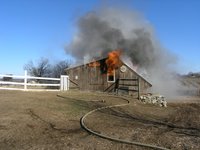Twins beat odds and raise money for the cause

By Janelle Randazza
PEABODY – Their parents call them a miracle, but they would rather talk about cars and dinosaurs. Twins Nathaniel and Avery Swanson celebrated their third birthday in January and they have defied expectations simply by being typical little boys.
Classified as “high-risk preemies,” the Swanson twins were born at only 24 weeks gestation – over four months premature. According to their parents, Jon and Jennifer, the odds were against the twins from day one. Weighing in at 1.8 and 1.9 ounces, the boys’ entry into the world was not an easy one. A high-risk pregnancy and a difficult delivery were followed by months of surgery and uncertainty.
Nathanial and Avery spent their first six months in Beth Israel’s neonatal intensive care unit (NICU) fighting for life. Both twins suffered myriad ailments and difficult medical procedures during the first six months of life. From a Grade III bilateral brain bleed, to weekly spinal taps, to a hole in Avery’s intestines, the Swansons questioned every day whether their boys would make it home and whether they would be able to lead a healthy and normal life.
“Every day I look at them and I just can’t believe the miracle I see. According to every statistic and everything we went through, my sons should not be here today,” says their mother, Jennifer Swanson. According to Swanson her boys would not be alive today if it weren’t for the staff at Beth Israel and for the support of the March of Dimes.
“The March of Dimes and their PRI [Premature Research Initiative] funded the study that was needed to develop the medicine I took to make sure my babies’ lungs would develop. I took it before they were born, while their lungs were still developing, and that medicine saved their lives. I can confidently say that, without the March of Dimes, Nathaniel and Avery would not be here today,” said Swanson.
A SILENT CRISIS
The March of Dimes calls premature births “the silent crisis.” Between 1981 and 2003, the rate of premature births increased by 31 percent. Each year nearly half a million infants will be born pre-term. That's a number roughly comparable to the population of Cleveland. Preterm deliveries are happening at an increasing rate and, in nearly half the cases, no one knows why.
Today, 1 in 8 babies will be born prematurely in the United States alone. Half of all neurological disabilities in children are related to premature birth. While tremendous advances have been made in caring for babies born pre-term, scientists have not yet developed effective ways to help prevent premature delivery. In 2003, the very year the Swanson boys were born, the March of Dimes launched a multiyear, multimillion-dollar campaign to address this growing problem.
A SINGULAR MISSION
With their own life and death struggle behind them, the Swansons have set their sites on helping others. Every year since their sons were born the couple has brought together a team of friends, family and co-workers to raise money for the organization’s annual fundraiser and awareness mission: WalkAmerica.
In 2005, more than 24,000 teams participated nationally in WalkAmerica. The Swanson’s raised nearly $5000 for the organization, the most money out of any group fundraisers in Massachusetts; this year they hope to raise even more.
According to Jennifer Swanson, the couple had always approached fundraising for the cause in a very non-intrusive way.
“We never wanted people to feel like they had to give their money directly to us… We don’t care how the March of Dimes gets the money, as long as they get it,” said Swanson. What was important to them was that people were aware of the epidemic proportions that premature births have reached. To help educate others on the issues of premterm births and to keep friends and family abreast of the twins’ progress, the Swansons built www.theSwansonboys.com. The website has information on preterm births and links to the March of Dimes website.
“We went through a heck of a rollercoaster ride emotionally. We expected joy but every day was sheer fear. We watched our sons get whisked off for one procedure or another on a daily basis. We don’t think anyone should ever feel the emotions we felt and we want to do anything we can to help anyone who has to go down the road,” said the boys’ father, Jon Swanson.
LITTLE AMBASSADORS
Despite six months of worry and numerous warnings that their sons could experience learning problems, chronic lung disease, vision and hearing problems—and other developmental delays common in premature babies—the Swanson twins continue to thrive. According to their parents the boys are intellectually curious and their motor and verbal skills are right on track. Today, the boys are happy and playful and, according to their parents, “the best of friends.” Their favorite things are dinosaurs, trucks and their four-month-old brother, Elijah.
“They just love being with each other. They are, in every way, just typical little boys. We can’t believe how fortunate we have been,” said Jennifer Swanson.
Jon Swanson hopes his sons’ success will bring hope to other families. The twins are constant visitors to Beth Israel’s NICU, but not as patients—they now visit the hospital to say hello to the people who saved their lives and to bring hope to struggling families.
“I love bringing the boys up there and showing other families the hope they can have because of my boys… We want to bring hope to other families who are dealing with the same thing. My boys were given less than a 20 percent chance of living, so when we go up there we are letting other parents know that they can hope for miracles too.”
How You Can Help
Visit www.theswansonboys.com to give to the Swanson’s fundraising efforts and to see how the boys are progressing, or visit www.walkamerica.org to contribute directly to the March of Dimes.
About the Prematurity Campaign
The March of Dimes Prematurity Campaign is a multimillion-dollar research, awareness and education campaign to help families have healthier babies. The campaign includes:
• Funding research to find the causes of premature birth.
• Educating women about the risk reduction strategies, including the signs and symptoms of premature labor.
• Providing support to families affected by prematurity.
• Expanding access to health care coverage so that more women can get prenatal care.
• Helping health care providers learn ways to help reduce the risk of early delivery.
• Advocating for access to insurance to improve maternity care and infant health outcomes.
--Courtesy of www.marchofdimes.com






